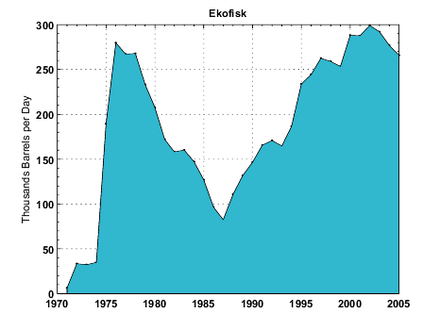Ekofisk oil field
| Ekofisk | |
|---|---|
Early Paleocene and Late Cretaceous ages) |
Ekofisk is an oil field in block 2/4 of the Norwegian sector of the North Sea about 320 km (200 mi) southwest of Stavanger. Discovered in 1969 by Phillips Petroleum Company,[1] it remains one of the most important oil fields in the North Sea. This was the first discovery of oil after the drilling of over 200 exploration wells in the North Sea "triggered" by the Groningen gas field discovery.[2] In 1971, Phillips started producing directly to tankers from four subsea wells.[3] Oil production is planned to continue until at least 2050.[4]
The Greater Ekofisk Area consists of Cod, Ekofisk, West Ekofisk, Tor, Albuskjell, Eldfisk, Edda and Embla oil fields. The Ekofisk Center is a vast complex of platforms and structures creating a transportation hub also for surrounding fields such as Valhall, Hod, Gyda, Ula, Statfjord, Heimdal, Tommeliten and Gullfaks. The whole complex consists of 29 platforms.[3] Produced oil is transported by the Norpipe oil pipeline to the Teesside Refinery in England.[5] Natural gas is transported by the Norpipe gas pipeline to Emden in Germany.[6]
Geology
The Ekofisk field is a north–south trending
The structure was discovered using seismic reflection data in the 1960s, although the initial interpretations were distorted due to zones of high gas saturation in the overlying Cenozoic rocks causing low seismic velocities.[7] However, the high porosity of the reservoir rock does cause an increase in seismic amplitude which can be used with an isopach map to determine net pay.[7]
Subsidence
In the mid-1980s the Ekofisk field as a whole and the platforms in particular were found to be suffering from an unexpected degree of
The Norwegian government pressed Phillips to take action and the French company Technip was ordered to find a solution. As 5 of 7 platforms were interconnected, they had to be jacked-up by about 6 m (20 ft) at the same time. The solution was that the steel tubular legs of the platforms would be extended. Subsequently, large flanges were welded to these legs and when all flanges were welded and the legs cut, five platforms would be lifted simultaneously in one operation then extension pipes would be mounted in between the flanges. After bolting all flanges the platforms would be safe again.
The four days lifting was completed on 17 August 1987, at 11:30 p.m. thanks to 108 hydraulic cylinders synchronised with a network of 14 NUM 760F
Bravo blowout
In April 1977, an oil well blowout occurred at the Ekofisk Bravo platform, due to an incorrectly installed downhole safety valve.[13] At an estimated 80,000–126,000 barrels (12,700–20,000 m3) total, it was the largest blowout in the North Sea. Red Adair and his crew assisted with capping the blowout.[14]
Images
-
Annual oil production from Ekofisk.
-
The Ekofisk complex in 2010.
-
Petroleum production of Norway by year and oil field
Further reading
- Kvendseth, Stig S. (1988). Giant discovery - A history of Ekofisk through the first 20 years. Phillips Petroleum Company Norway, Public Affairs. ISBN 8299177111.
See also
- List of oil and gas fields of the North Sea
- Commercial offshore diving in the North Sea
- List of oil spills
- Alexander L. Kielland (platform) 1980 disaster
References
- ^ "The NPD's Fact-pages – EKOFISK]". NPD. Retrieved 14 September 2012.
- ^ Van den Bark, E., and Thomas, O.D., 1980, Ekofisk: First of the Giant Oil Fields in Western Europe, in Giant Oil and Gas Fields of the Decade: 1968-1978, AAPG Memoir 30, Tulsa, American Association of Petroleum Geologists, pp. 195-197
- ^ a b "Ekofisk Center". SubseaIQ. Bishop Interactive. Archived from the original on 7 August 2011. Retrieved 15 May 2010.
- ^ "Ekofisk". Archived from the original on 26 September 2013. Retrieved 19 September 2013.
- ^ "ConocoPhillips Gets Go Ahead to Use Norpipe Oil Pipeline Until 2028". Rigzone. 22 July 2008. Retrieved 10 November 2009.
- ^
"Natural gas in the Nordic countries" (PDF). Nordic Energy Perspectives. March 2009: 31. Archived from the original (PDF) on 27 July 2011. Retrieved 10 November 2009.
{{cite journal}}: Cite journal requires|journal=(help) - ^ a b c Van den Bark, E., and Thomas, O.D., 1980, Ekofisk: First of the Giant Oil Fields in Western Europe, in Giant Oil and Gas Fields of the Decade: 1968-1978, AAPG Memoir 30, Tulsa, American Association of Petroleum Geologists, p. 211
- ^ Van den Bark, E., and Thomas, O.D., 1980, Ekofisk: First of the Giant Oil Fields in Western Europe, in Giant Oil and Gas Fields of the Decade: 1968-1978, AAPG Memoir 30, Tulsa, American Association of Petroleum Geologists, pp. 195, 208 and 200
- ^ Van den Bark, E., and Thomas, O.D., 1980, Ekofisk: First of the Giant Oil Fields in Western Europe, in Giant Oil and Gas Fields of the Decade: 1968-1978, AAPG Memoir 30, Tulsa, American Association of Petroleum Geologists, p. 200
- ^ Van den Bark, E., and Thomas, O.D., 1980, Ekofisk: First of the Giant Oil Fields in Western Europe, in Giant Oil and Gas Fields of the Decade: 1968-1978, AAPG Memoir 30, Tulsa, American Association of Petroleum Geologists, pp. 211-213
- ^ Sulak, R. M. & Danielsen, J. (1989), Reservoir aspects of Ekofisk subsidence Journal of Petroleum Technology, Society of Petroleum Engineers, 41, 709-716
- ^ "Special Ekofisk" (PDF). NUM. October 1987: 1–2. Archived from the original (PDF) on 23 July 2011. Retrieved 26 January 2011.
{{cite journal}}: Cite journal requires|journal=(help) - ^ Oil Rig Disasters – Ekofisk Bravo Platform Archived 3 December 2010 at the Wayback Machine
- ^ "Red Adair, Oilwell Firefighter, American Hero – His Story..." Archived from the original on 17 July 2008. Retrieved 15 May 2010.




